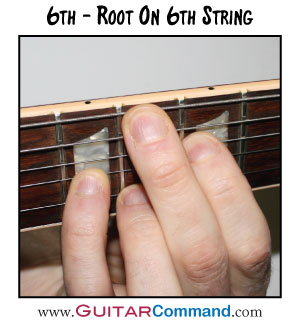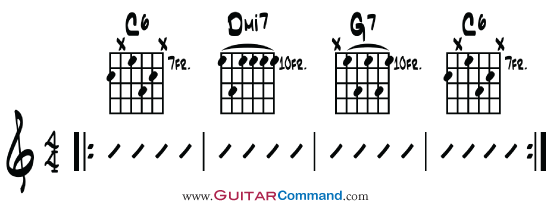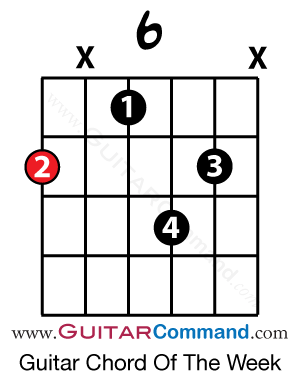This week's Guitar Chord Of The Week is a sixth chord (also called 6, added sixth, add6 or major 6).
This is a pleasant-sounding chord that is often used as a substitution for a major chord.
Read on to find out how the 6 chord is constructed and how to play it. Then, try it out in an example chord progression...
Sixth Chord Guitar
This particular 6th chord voicing can be a little tricky to play at first. However, like many of these 'jazzier' chords, once you start using it you'll find that it's actually one of the easier movable chord shapes.
How To Play The 6 Chord
A good way of hitting this chord reliably is to concentrate on positioning the second and first fingers first. By doing this the third and fourth fingers will automatically fall into place.

The fifth and first strings are not played in this chord. This may seem strange if you are used to strumming standard major or minor chords. The trick is to position the other fretting fingers so that they are damping the unused strings.
In this sixth chord voicing, the second (middle) finger should be positioned so that is is touching the fifth string just enough to mute it. Muting strings with the other fretting fingers may seem awkward at first but it is a useful technique and helpful in several other aspects of guitar playing.
[ad name="Google Adsense Lge Rec"]
Sixth Chord Theory
In popular music, a sixth chord is a major triad with an additional major sixth note (in classical music theory the definition alters). It can also be called an 'added sixth chord'. The symbol for a sixth chord is a '6' after the root, i.e. C6 for a C major sixth chord. Alternatively, the symbol 'Add6' can be used.
The notes in a C6 chord are: C E G A. The A is the added sixth note.
The notation for the 6 chord shape shown above is:

Major 6th Chord Substitutions
One interesting feature of the 6 chord is that it contains the same notes as the minor 7th chord whose root is a minor third below it. Compare a C6 chord with an Am7 chord:
C6 Notes: C E G A
Am7 Notes: A C E G
This means that the two chords can be substituted for each other (as they are essentially the same chord).
The sixth chord is also often used as a substitution for a major chord with the same root. For example, a C6 chord can be played instead of a standard C chord. Try playing a 6 chord instead of a major chord in any chord progression and listen out for the subtle difference in tone.
Example Chord Progression Using A Sixth Chord
Try playing this jazz chord progression to get a feel for playing the 6th chord.

[ad name="Google Adsense Lge Rec"]
Check back next week for a new chord!


